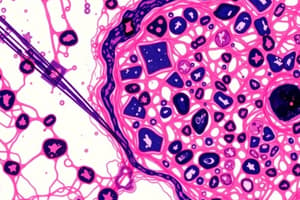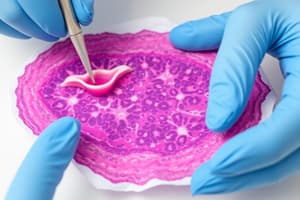Podcast
Questions and Answers
Which type of tissue is characterized as loose connective tissue?
Which type of tissue is characterized as loose connective tissue?
What type of fibres are predominantly found in the periodontal ligament (PDL)?
What type of fibres are predominantly found in the periodontal ligament (PDL)?
Which of the following descriptions best characterizes compact or cortical bone?
Which of the following descriptions best characterizes compact or cortical bone?
Which type of salivary gland is primarily mucous secreting?
Which type of salivary gland is primarily mucous secreting?
Signup and view all the answers
What histological feature may be observed in cancerous tissues?
What histological feature may be observed in cancerous tissues?
Signup and view all the answers
Which characteristic does the stratum spinosum exhibit?
Which characteristic does the stratum spinosum exhibit?
Signup and view all the answers
What is the histological appearance of the parotid gland?
What is the histological appearance of the parotid gland?
Signup and view all the answers
Which type of bone is described as loose and lacking a Haversian system?
Which type of bone is described as loose and lacking a Haversian system?
Signup and view all the answers
What defines the composition of Sharpey's fibers in the periodontal ligament?
What defines the composition of Sharpey's fibers in the periodontal ligament?
Signup and view all the answers
Which type of specialized mucosa is known for containing many taste buds?
Which type of specialized mucosa is known for containing many taste buds?
Signup and view all the answers
Study Notes
Tissue Processing Types
- Fixation: Preserves tissue structure
- Dehydration: Removes water
- Clearing: Replaces water with a solvent miscible with wax
- Embedding: Tissue is infiltrated with wax for support
- Sectioning: Thin slices made for viewing under microscope
- Staining: Used to enhance visualization of structures
Pulp
- Loose connective tissue
- ECM: Abundant ground substance; collagen fibers (types I and III)
-
Cells:
- Fibroblasts: Produce collagen fibers
- Odontoblasts: Form dentin
- Undifferentiated mesenchymal cells: Potential for differentiation
- Blood vessels: Supply nutrients and remove waste
- Nerves: Sensitive to stimuli
- Macrophages: Immune cells
Periodontal Ligament (PDL)
- Principle and Sharpey's fibers are collagen fibers (types I and III)
-
Cells:
- Fibroblasts: Produce collagen fibers
- Cementoblasts: Form cementum
- Osteoblasts: Form alveolar bone
- Osteoclasts: Resorbs alveolar bone
- Undifferentiated mesenchymal cells: Potential for differentiation
- Blood vessels: Supply nutrients and remove waste
- Nerves: Sensitive to stimuli
Bone
- Compact/Cortical: Dense, Haversian system with osteons
- Trabecular/Spongy/Cancellous: Loose
- Woven: Immature, less organized
Specialised Mucosa
- Prickle/Spinous Layer (Stratum Spinosum): Cell-cell adhesion molecules visible
- Filiform: Keratinized, most numerous papillae, no taste buds
- Fungiform: Lateral border of tongue, some taste buds
- Circumvallate: Large, V-shaped papillae, numerous taste buds
- Von Ebner's Glands: Serous glands that open into clefs surrounding circumvallate papillae
Salivary Glands
- Sublingual: Mainly mucous secreting, appears lighter in histology
- Submandibular: Mix of serous and mucous secretions, has light and dark areas
- Parotid: Serous secreting, appears darker in histology
Cancer
- Histological Features: Sometimes produce keratin pearls
Tissue Processing Types
- Formalin fixation - used to preserve tissue structure
- Dehydration - removes water from tissue
- Clearing - replaces water with a solvent that is miscible with both water and paraffin wax
- Embedding - tissue is infiltrated with paraffin wax to give it rigidity
- Sectioning - thin slices of tissue are cut using a microtome
- Staining - sections are stained to highlight different components of the tissue
Pulp
- Loose connective tissue
- Extra Cellular Matrix (ECM) contains collagen fibres and ground substance
- Cells include fibroblasts, odontoblasts, macrophages, and lymphocytes
Periodontal Ligament (PDL)
- Principle and Sharpey's fibres are composed of collagen type I and III
- Cells include fibroblasts, cementoblasts, osteoblasts, and epithelial rests of Malassez
Bone
- Compact/Cortical bone is dense and contains Haversian systems and osteons
- Trabecular/Spongy/Cancellous bone is loose and porous
- Woven bone is immature and found in areas of rapid bone formation
Specialised Mucosa
- Prickle/Spinous layer (stratum spinosum) exhibits cell-cell adhesion molecules visible under a microscope
- Filiform papillae are keratinized and provide a rough surface for the tongue
- Fungiform papillae are located on the lateral borders of the tongue and contain some taste buds
- Circumvallate papillae are large and possess many taste buds
- Von Ebner's glands are serous glands that secrete into the clefs of the circumvallate papillae
Salivary Glands
- Sublingual gland is mainly mucous secreting and appears lighter histologically
- Submandibular gland contains both mucous and serous secreting cells, giving it a mixed appearance
- Parotid gland is serous secreting and appears darker histologically
Cancer
- Histological examination may reveal keratin pearls, which are characteristic of some types of cancer.
Studying That Suits You
Use AI to generate personalized quizzes and flashcards to suit your learning preferences.
Related Documents
Description
This quiz covers the various types of tissue processing, including fixation, dehydration, clearing, embedding, sectioning, and staining. It also explores the characteristics of pulp and periodontal ligament, detailing the different cell types and their functions in oral connective tissues.




